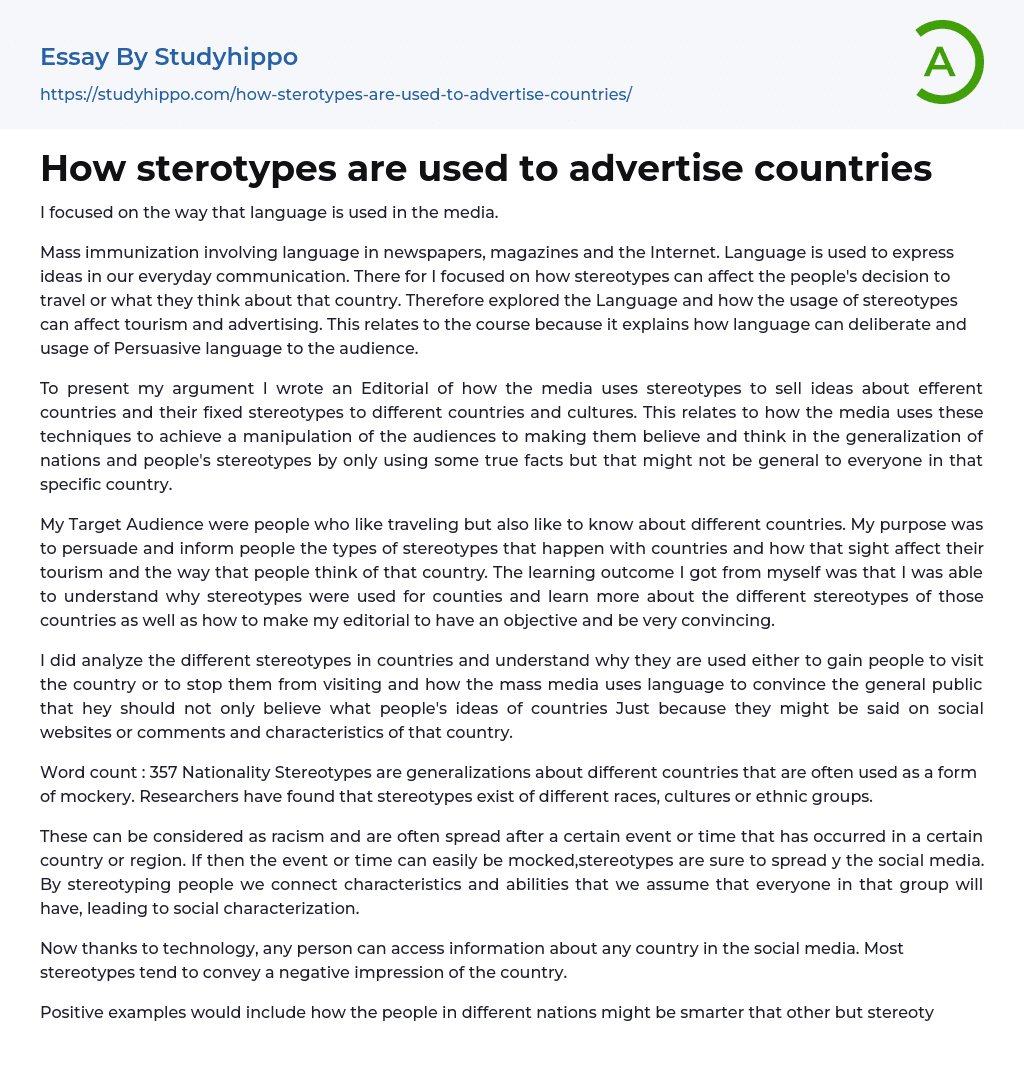

How sterotypes are used to advertise countries Essay Example
My examination of language in media focused on mass immunization through newspapers, magazines, and the Internet. The use of language is a means to express ideas in everyday communication. I explored how stereotypes impact people's travel decisions and their perceptions of certain countries. This relevance is significant as it explains how persuasive language can be used to influence audiences. To present my argument, I composed an editorial that scrutinizes how the media peddles fixed stereotypes about different countries and cultures by exploiting these techniques. These methods manipulate audiences into accepting generalizations about nations and people's stereotypes that may not necessarily apply across the board.
The target audience for my editorial consisted of individuals who enjoy traveling and have an appetite for knowledge about various countries. My goal was to persuade and inform them about the various forms of stereotypes that influence
...the tourism industry and shape perceptions of particular countries. By engaging in self-learning, I gained insights into stereotype usage regarding nations which helped me create compelling, objective editorials.
Through analysis, I identified reasons behind using stereotypes to either entice or deter people from visiting specific destinations within a country.The text discusses the influence of mass media language on people's opinions about a country based on stereotypes. Stereotyping based on nationality is a form of racism that spreads easily through social media after significant events or periods in specific regions or countries, leading to social characterization. In today's technological era, it is effortless for people to access information about any country through social media, unfortunately projecting negative impressions of countries. Negative stereotypes are more common and often created to mock a certain country or race. Mass communication
plays a significant role in spreading and forming these stereotypes through various platforms such as newspapers, magazines, television, internet and social networks. Advancements in communication technology have made it easier for these stereotypes to be present in social media and accessible all over the world. Africa is commonly portrayed as one large country instead of recognizing its diversity with common depictions including wild animals, diamond mines, undiscovered civilizations and primitive villages.African people are often portrayed as superstitious and practicing witchcraft, living in huts and using spears and shields to defend themselves. However, this stereotype is inaccurate since Africa has much to offer as a beautiful continent. Germans are often seen as militaristic due to the events of World War I and II which resulted in a strict sense of organization and efficiency. Unfortunately, this perception has led others to view them as humorless and unfriendly. Americans are frequently viewed as greedy, entitled, and overweight due to fast food culture, but this stereotype does not represent their true nature. Canadians may be depicted as Mounties or wildlife hunters living in igloos who love maple leaves and syrup but are known for their polite demeanor towards tourists. In contrast, Latin America is associated with short-term dictatorships, drug trafficking, executions by firing squad, soccer players, dancers while Mexicans may be seen wearing sombreros with long black mustaches performing traditional dances playing serenades on the guitar eating spicy foods containing beans,corn,and peppers while drinking tequila.Latin Americans are often unjustly portrayed as lazy and unproductive people who take naps in hammocks or against walls. Moreover, if they lack legal documentation when in America, they are labeled as "The Illegal." These
stereotypes generate fear that the region is full of indolent and hazardous individuals involved with drug trafficking and violent behavior, which makes tourists feel unwelcome.
Similarly, some non-Asian individuals mistakenly consider all Southeast Asian descendants to be Chinese, regardless of their place of birth. Popular misconceptions about Chinese people include throwing babies into rivers, extreme animal cruelty, women wearing small shoes, lighting fireworks, mythological creatures like Chinese dragons, playing ping-pong excessively and the belief that the Chinese eat anything that moves. Such misrepresentations discourage some Western cultures from traveling to China by creating an impression that it is a country filled with sexist individuals with poor manners and personality-free Mao fanatics.
However, while some aspects of these stereotypes hold true to reality; others are mere exaggerations. Furthermore, people's perceptions of countries frequently do not match up to what they anticipated based on preconceived notions. For instance; not all foreigners speak heavily accented English as depicted in movies or TV shows.
- Cattle essays
- Territory essays
- Social Media Negative Effects essays
- Effects of Social Media essays
- Animal Abuse essays
- Cats Vs Dogs essays
- Distribution essays
- Large Animals essays
- Mouse essays
- Poultry essays
- Rabbit essays
- Collaboration essays
- Dialogue essays
- Fake News essays
- Journalism essays
- Mass Media essays
- Media Analysis essays
- Media Bias essays
- Media Studies essays
- Message essays
- News essays
- Propaganda essays
- Radio essays
- Rogerian Argument essays
- Role of Media essays
- Social Media essays
- Social Media Marketing essays
- Social Networking essays
- Youtube essays
- Anthropology essays
- Audience essays
- Charity essays
- Cultural Competence essays
- Emile Durkheim essays
- Gender Roles essays
- Generation essays
- Globalization essays
- Interpersonal Relationship essays
- People essays
- Race essays
- Social Change essays
- Social Class essays
- Social Movement essays
- Social Science essays
- Social Status essays
- Social Stratification essays
- Society essays
- Sociological Imagination essays
- Sociological Perspective essays
- Sociological Theories essays



